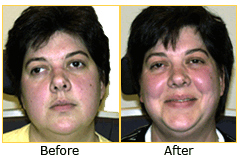Giving Heather new confidence
The day Heather Barlow came to Boston Children's Hospital for surgery to correct the misaligned eye (strabismus) she had lived with for a decade, it never occurred to her that she would be going home the same day with straight eyes.
Yet after recovering from anesthesia, Barlow, 34, looked in the mirror and was overcome with emotion. "It was the most surreal feeling. When I looked at myself in the mirror, there was the old me looking back," she says. "Although I obviously knew I was having surgery, I just didn't expect to be able to see the result so fast."
Car Accident Causes Damage
Barlow developed strabismus after suffering a traumatic eye injury in a car accident. After two operations to repair a detached retina, her eye began to drift outward. Her surgeon at Massachusetts Eye and Ear Infirmary suggested she go to Boston Children's Hospital where pediatric ophthalmologists have special expertise in treating adults with strabismus. But she initially declined.
Living with Strabismus
 She explains that at the time she wasn't interested in having more surgery and, after surviving a major car accident, she felt she should be grateful for the way everything turned out. Even though she was experiencing double vision - a debilitating sign of strabismus in adults - Heather felt she could live with the problem. Yet slowly, she became very self-conscious about the way she looked.
She explains that at the time she wasn't interested in having more surgery and, after surviving a major car accident, she felt she should be grateful for the way everything turned out. Even though she was experiencing double vision - a debilitating sign of strabismus in adults - Heather felt she could live with the problem. Yet slowly, she became very self-conscious about the way she looked.
"When I met people for the first time or even when I just talked to people, I would wonder, 'Are they looking at my eye?' she says. "I felt like I stood out and I was always aware of it. My self esteem and self confidence were completely lost."
Meeting Dr. Hunter
About 10 years after the accident, she decided to revisit the idea of fixing the strabismus. After meeting David Hunter, MD, PhD, chief of Ophthalmology at Boston Children's Hospital, who told her he could fix her eye, Heather gained the confidence to undergo eye muscle surgery. In addition to recommending surgery, Dr. Hunter advised that she wear a contact lens on her bad eye, because her natural lens had been removed during the operation to repair her retina. A contact lens would enable her eye to focus light properly and help restore binocular (single) vision after her eyes were straightened.
The Surgery
"I've had major surgeries so I was nervous about going in," she says. "But the staff explained everything very carefully, so I felt very prepared and comfortable. The only part I wasn't looking forward to was the adjustments after waking up."
During eye muscle surgery, which is performed under general anesthesia, the eye muscle or muscles causing the misalignment are separated from the eye and reattached to a new position. In most adults, adjustable sutures are used that allow surgeons to make further adjustments to the eye if needed after the patient wakes up.
"The adjustments turned out to be very simple," says Barlow. "My eye was numb. The procedure was uncomfortable, but it was very quick."
Great Results
The results, she said, were well worth it. "I had the surgery two months ago. My eyes are totally straight and they look great. My double vision has improved. I still see shadows, but I'm told that as I continue to wear the contact lens, the shadows should subside."
"I feel silly that I waited so long to do this," she says. "Knowing what I know now, I would do it all over again if I had to."
Go to Adults with Strabismus Program